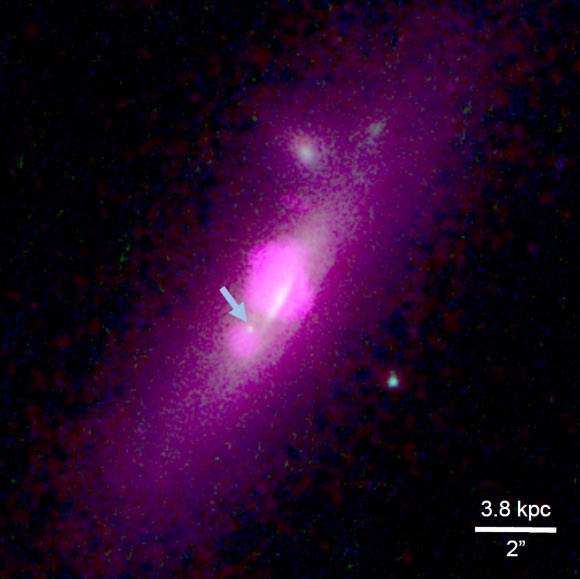
Composite image from the NASA/ESA Hubble Space Telescope and NASA’s Chandra X-ray Observatory which shows the galaxy SDSS J112659.54+294442.8. The arrow points to the galactic core fragment that fisioned from the galaxy’s central core. Image credit: NASA / ESA / Hubble Team / Chandra Team / Julia M. Comerford et al.
Posted by P. LaViolette, February 4, 2016
In the June 2015 issue of the Astrophysical Journal a team of astronomers led by Dr Julia Comerford of the University of Colorado, Boulder report their observations of the central region of the distant edge-on disc galaxy SDSS J1126+2944 at a redshift of z = 0.102; see their paper at http://arxiv.org/pdf/1504.01391.pdf?. The arrow in the above composite X-ray and optical image of the galaxy’s nucleus points to an ultra luminous X-ray source (intermediate mass mother star) that has been designated as J1126+2944SE. It is estimated to have a mass between 100 and 1 million solar masses and is found to be situated within about 2.2 kiloparsecs (7000 ly) of the galaxy’s active core.
The interpretation provided by subquantum kinetics is that we are witnessing here the rare event of the fissioning of a galaxy’s supermassive core. Such events occur from time to time in the life of a growing mother star. Mother star’s continuously grow in mass due to the process of matter creation that takes place within them. As a result, they grow in size and in some instances fission producing a daughter mother star, usually of lower mass. Mother stars also lose mass by continuously expelling an ionized gas wind, especially during times when they are in their active phase. Such core fissioning, in my opinion, is what produces satellite galaxies, such as the dwarf elliptical satellites seen around our nearest neighbor the Andromeda galaxy. The Large Magellenic Cloud and the Small Magellenic Cloud also likely originated from expulsions, in this case from our own Galactic core.
Comerford et al. note that the outlying core is relatively devoid of stars. This is to be expected in the case of a recent core fission event since the expelled mother star would not have had sufficient time to build up the cluster of stars that usually is seen to surround such supermassive objects.
For a news report about this finding see: http://www.sci-news.com/astronomy/pair-black-holes-distant-galaxy-03546.html
As you will see from reading the above news report, as well as the Astrophysical Journal paper, the authors have interpreted their finding within the standard big bang cosmological paradigm which assumes that galaxies grow only through merging with neighboring galaxies. So rather than a fissioning process, they interpret the close proximity of this ultra luminous X-ray source (ULX) to the galaxy’s core as an indication that the parent galaxy is capturing an incoming galaxy. The problem with this interpretation is that the ULX is not embedded in any incoming galaxy. In fact, it is even devoid of a surrounding stellar cloud. Comerford et al. propose that the core appears bare because the “incoming galaxy” was stripped of its stars, but admit that J1126+29944 shows no signs of tidal disruption.
But doesn’t it seem odd that this “captured core, stripped of its stars” would happen to reside so close to the parent galaxy’s core. In terms of galactic dimensions, 7000 light years is very close. Also note that it is rather closely aligned with the parent galaxy’s galactic plane. Either all this is a total coincidence, or the probabilities look diminishingly small that J1126+29944SE was from an incoming galaxy and far more probable that it originated from a core ejection. The galactic core fission interpretation appears to better explains the data and adds to the abundant evidence already available which supports the core fissioning hypothesis. For more evidence about galactic core fissioning read Subquantum Kinetics.
